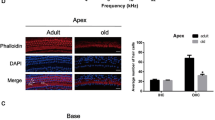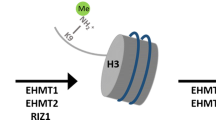Abstract
It is currently accepted that epigenetics plays an important role in normal genetics and differentiation, and its failure triggers various diseases such as cancer, aging, metabolic diseases, and abnormal differentiations. The typical mechanism involves the modification of histones and the methylation of DNA. In this study, we investigated the modification of histones in the aged cochlea of mice using immunohistochemistry. Eight mice [C57BL/6(B6)] at the age of 8 weeks (young group) and 132 weeks (aged group) were used. Cochleas were fixed with paraformaldehyde and then decalcified. Hematoxylin-eosin staining was performed for the morphological study using a light microscope. After removing paraffin, the sections were incubated with the primary antibody to acetyl-histone H3 Lys9 or dimethyl-histone H3 Lys9. Confocal scanning microscopy was performed for observation. The degeneration was severest in the spiral ganglion cells and the organ of Corti of the basal turn as determined by light microscopy. Acetylated histone H3 was detected in the spiral ganglion cells and the organ of Corti of the young group, but not in those of the aged group. Dimethylated histone H3 was detected in the spiral ganglion cells and the organ of Corti of the aged group, but not in those of the young group. Acetylation was switched to methylation during ageing. Histone modification is known to have a critical role in neuro-degeneration. Our findings suggest that epigenetic change participates in the process of presbycusis.





Similar content being viewed by others
References
Waddington CH (1942) Canaliyation of development and the inheritance of acquired characters. Nature 3811:563–565
Ushijima T, Okochi-Takeda E (2005) Aberrant methylations in cancer cells: where do they come from? Cancer Sci 96:206–211
Christensen BC, Marsit CJ (2011) Epigenomics in environmental health. Front Genet 84:1–10
Issa JPJ, Ottaviano YL, Celano P, Hamilton SR, Davidson NE, Baylin SB (1994) Methylation of the oestrogen receptor CpG island links ageing and neoplasia in human colon. Nat Genet 7:536–540
Jones PA, Baylin SB (2007) The epigenomics of cancer. Cell 23:683–692
Fraga MF, Ballestar E, Paz MF, Ropero S, Setien F, Ballestar ML et al (2005) Epigenetic differences arise during the lifetime of monozygotic twins. PNAS 26:10604–10609
Lee S, Jung JW, Park SB, Roh K, Lee SY, Kim JH, Kang SK, Kang KS (2011) Histone deacerylase regulates high mobility group A2-targeting microRNAs in human cord blood-derived multipotent stem cell aging. Cell Mol Life Sci 68:325–336
Slattery EL, Speck JD, Warchol ME (2009) Epigenetic influences on sensory regeneration: histone deacerylases regulate supporting cell proliferation in the avian utricle. JARO 10:342–353
Huang Q, Tang J (2010) Age-related haring loss or presbycusis. Eur Arch Otorhinolaryngol 267:1179–1191
Staecker H, Zheng GY, Van De Water TR (2001) Oxidative stress in aging in the C57B16/J mouse cochlea. Acta Otolaryngol 121:666–672
Friedman LM, Avraham KB (2009) MicroRNAs and epigenetic regulation in the mammalian inner ear: implications for deafness. Mamm Genome 20:581–603
Rodriguez-Rodero S, Fernandez-Morera JL, Fernandez AF, Menendez-Torre E, Fraga MF (2010) Epigenetic regulation of aging. Discov Med 10:225–233
Kouzarides T (2007) Chromatin modifications and their function. Cell 128:693–705
Strahl BD, Allis CD (2000) The language of covalent histone modifications. Nature 403:41–45
Gaikwad AB, Sayyed SG, Lichtenkert J, Tikoo K, Anders HJ (2010) Renal failure increased cardiac histone H3 acetylation, dimethylation, and phosphorylation and the induction of cadiomyopathy-related genes in type 2 diabetes. Am J Pathol 176:1079–1083
Song C, Kanthasamy A, Anantharam V, Sun F, Kanthasamy AG (2010) Environmental neurotoxic pesticide increases histone acetylation tos promote apoptosis in dopaminergic neuronal cells: relevance to epigenetic mechanisms of neurodegeneration. Mol Pharmacol 77:621–632
Aguilera O, Fernandez AF, Munoz A, Fraga MF (2010) Epigenetics and environment: a complex relationship. J Appl Physiol 109:243–251
Garcia SN, Pereira-Smith O (2008) MRGing chromatin dynamics and cellular senescence. Cell Biochem Biophys 50:133–141
Sandri-Vakili G, Bouzou B, Benn CL, Kim WO, Chavia P, Overland RP, Glajch KE, Xia E, Qiu Z, Hersch SM, Clark TW, Yohrling GJ, Cha JHL (2007) Histone associated with downregulated genes are hypo-acetylated in Huntingron’s disease models. Hum Mol Genet 16:1293–1306
Clayton AL, Rose S, Barratt MJ, Mahadevan LC (2000) Phosphoacetylation of histone H3 on c-fos- and c-jun-associated nucleosomes upon gene activation. EMBO J 19:3714–3726
Schuknecht HF (1964) Further observations on the pathology of presbycusis. Arch Otolayngol 80:369–382
Nelson EG, Hinojosa R (2006) Presbycusis: a human temporal bone study of individuals with downward sloping audiometric patterns of hearing loss and review of the literature. Laryngoscope 116:1–12
Henry KR, Chole RA (1980) Genotypic differences in behavioral, physiological and anatomical expressions of age-related hearing loss in the laboratory mouse. Audiology 19:369–383
Kazee AM, Han LY, Spongr VP, Walton JP, Salvi RJ, Flood DG (1995) Synaptic loss in the central nucleus of the inferior colliculus correlates with sensorineural hearing loss in the C57BL/6 mouse model of presbycusis. Hear Res 89:109–120
Keithley EM, Canto C, Zheng QY, Fischel-Ghodsian N, Johnson KR (2004) Age-related hearing loss and ahl locus in mice. Hear Res 188:21–28
Acknowledgments
The authors thank Prof. Olaf Michel for his assistance.
Author information
Authors and Affiliations
Corresponding author
Rights and permissions
About this article
Cite this article
Watanabe, Ki., Bloch, W. Histone methylation and acetylation indicates epigenetic change in the aged cochlea of mice. Eur Arch Otorhinolaryngol 270, 1823–1830 (2013). https://doi.org/10.1007/s00405-012-2222-1
Received:
Accepted:
Published:
Issue Date:
DOI: https://doi.org/10.1007/s00405-012-2222-1




